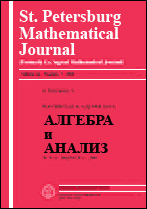|
This article is cited in 3 scientific papers (total in 3 papers)
Research Papers
Spectral analysis of the generalized surface maryland model
F. Bentoselaa, Ph. Brieta, L. Pasturb
a Centre de Physique Theorique, Luminy, Marseille, France
b U.F.R.de Mathématiques Université Paris 7, France
Abstract:
The $d$-dimensional discrete Schrödinger operator whose potential is supported on the subspace $\mathbb Z^{d_2}$ of $\mathbb Z^d$ is considered: $H=H_a+V_M$, where $H_a=H_0+V_a$, $H_0$ is the $d$-dimensional discrete Laplacian, $V_a$ is a constant “surface” potential, $V_a(\mathrm x)=a\delta(x_1)$, $\mathrm x=(x_1,x_2)$, $x_1\in\mathbb Z^{d_1}$, $x_2\in\mathbb Z^{d_2}$, $d_1+d_2=d$ and $V_M(\mathrm x)=g\delta(x_1)\tan\pi(\alpha\cdot x_2+\omega)$ with $\alpha\in\mathbb R^{d_2}$, $\omega\in[0,1)$. It is proved that if the components of $\alpha$ are rationally independent, i.e., the surface potential is quasiperiodic, then the spectrum of $H$ on the interval $[-d,d]$ (coinciding with the spectrum of the discrete Laplacian) is purely absolutely continuous, and the associated generalized eigenfunctions have the form of the sum of the incident wave and waves reflected by the surface potential and propagating into the bulk of $\mathbb Z^d$. If, in addition, $\alpha$ satisfies a certain Diophantine condition, then the remaining part $\mathbb R\setminus[-d,d]$ of the spectrum is pure point, dense, and of multiplicity one, and the associated eigenfunctions decay exponentially in both $x_1$ and $x_2$ (localized surface states). Also, the ase of a rational $\alpha=p/q$ for $d_1=d_2=1$ (i.e., the case of a periodic surface potential) is discussed. In this case the entire spectrum is purely absolutely continuous, and besides the bulk waves there are also surface waves whose amplitude decays exponentially as $|x_1|\to\infty$ but does not decay in $x_2$. The part of the spectrum corresponding to the surface states consists of $q$ separated bands. For large $q$ the bands outside of $[-d,d]$ are exponentially small in $q$, and converge in a natural sense to the pure point spectrum of the quasiperiodic case with Diophantine $\alpha$'s.
Received: 17.03.2004
Citation:
F. Bentosela, Ph. Briet, L. Pastur, “Spectral analysis of the generalized surface maryland model”, Algebra i Analiz, 16:6 (2004), 1–27; St. Petersburg Math. J., 16:6 (2005), 923–942
Linking options:
https://www.mathnet.ru/eng/aa637 https://www.mathnet.ru/eng/aa/v16/i6/p1
|


| Statistics & downloads: |
| Abstract page: | 335 | | Full-text PDF : | 92 | | References: | 61 | | First page: | 1 |
|





 Contact us:
Contact us: Terms of Use
Terms of Use
 Registration to the website
Registration to the website Logotypes
Logotypes







 Citation in format
Citation in format 
